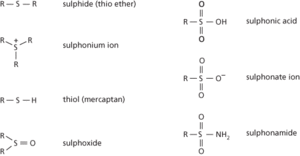A yellow nonmetallic element belonging to group 16 (formerly VIB) of the periodic table; a.n. 16; r.a.m. 32.06; r.d. 2.07 (rhombic); m.p. 112.8°C; b.p. 444.674°C. The element occurs in many sulphide and sulphate minerals and native sulphur is also found in Sicily and the USA (obtained by the Frasch process). It can also be obtained from hydrogen sulphide by the Claus process.
Sulphur has various allotropic forms. Below 95.6°C the stable crystal form is rhombic; above this temperature the element transforms into a triclinic form. These crystalline forms both contain cyclic S8 molecules. At temperatures just above its melting point, molten sulphur is a yellow liquid containing S8 rings (as in the solid form). At about 160°C, the sulphur atoms form chains and the liquid becomes more viscous and dark brown. If the molten sulphur is cooled quickly from this temperature (e.g. by pouring into cold water) a reddish-brown solid known as plastic sulphur is obtained. Above 200°C the viscosity decreases. Sulphur vapour contains a mixture of S2, S4, S6, and S8 molecules. Flowers of sulphur is a yellow powder obtained by subliming the vapour. It is used as a plant fungicide. The element is also used to produce sulphuric acid and other sulphur compounds.
Sulphur is an essential element in living organisms, occurring in the amino acids cysteine and methionine and therefore in many proteins. It is also a constituent of various cell metabolites, e.g. coenzyme A. Sulphur is absorbed by plants from the soil as the sulphate ion (SO42−). See sulphur cycle.

Sulphur compoundsSulphur
https://www.webelements.com/sulfur/ Information from the WebElements site
Symbol S. A yellow nonmetallic element that is an essential element in living organisms, occurring in the amino acids cysteine and methionine and therefore in many proteins. It is also a constituent of various cell metabolites, e.g. coenzyme A. Sulphur is absorbed by plants from the soil as the sulphate ion (SO42−). See sulphur cycle.
- gelivation
- Geller, Margaret Joan
- Gell-Mann, Murray
- Gell-Mann, Murray (1929–2019)
- gem
- Gemar, Sam (1955– )
- geminate pair
- Geminga
- Gemini
- Geminid meteors
- Gemini Observatory
- Gemini project
- gemma
- gemmation
- gemstone
- genal angle
- genal spine
- GenBank
- gendarme
- gender
- gender bender
- genderlect
- gene
- genealogy
- gene amplification